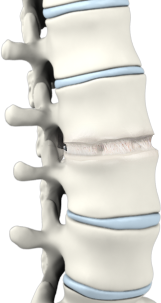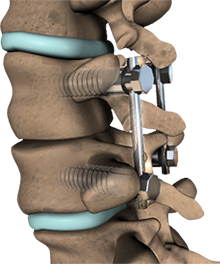
Anterior Lumbar Interbody Fusion (ALIF)
Anterior lumbar interbody fusion (ALIF) is a surgical procedure to correct the spinal problems from the front of the vertebral body by removing disc or other bone material from in between two adjacent lumbar vertebrae. The surgery can be implemented either as an open surgery or minimally invasive techniques.
What is the ALIF surgical approach?
Anterior lumbar interbody fusion (ALIF) is a spinal surgery that involves removal of all or part of a herniated disc from in between two contiguous vertebrae (interbody) from the front of the vertebral body in the lower back region (lumbar spine) and fusing or joining the two vertebrae together so that they heal into a single, solid bone. A bone graft or a substitute bone graft can be used on both sides of the remaining disc space of the vertebrae.
The graft material binds the two vertebrae together and promotes bone healing, facilitates the fusion and helps to preserve the normal disc height as the body heals. Along with the vertebral bone, the bone graft also grows and stabilizes the spine. An ‘internal cast’ made up of certain instruments such as rods, screws, plates, cages, hooks and wires can be used to support the vertebral structure during the healing process.
The graft material binds the two vertebrae together and promotes bone healing, facilitates the fusion and helps to preserve the normal disc height as the body heals. Along with the vertebral bone, the bone graft also grows and stabilizes the spine. An ‘internal cast’ made up of certain instruments such as rods, screws, plates, cages, hooks and wires can be used to support the vertebral structure during the healing process.
Your condition and your surgeon’s experience, training or preferred methodology may determine the performance of ALIF surgery alone or in combination with another spinal fusion approach. Discuss the options of surgical approach thoroughly with your doctor and depend on their decision for the most suitable approach for your condition.
What are the conditions that can be treated by (ALIF) surgery?
The recommendation of spinal fusion by a surgeon depends on various reasons and the procedure is most commonly used to treat conditions such as one or more fractured vertebra, spondylolisthesis or slippage of one vertebra over another, presence of abnormal curvatures of the spine such as scoliosis or kyphosis, any protrusion or degeneration of the disc (the cartilaginous structure that ‘cushions’ between vertebrae) and instability of the spine or excessive motion between two or more vertebrae.
Who are candidates for (ALIF) surgery?
Patients with certain symptoms such as low back or leg pain due to degeneration of disc, spondylolysis or spondylolisthesis, scoliosis or any spinal instability that have not responded to other non-surgical treatment measures such as rest, physical therapy or medications may be appropriate candidates for an ALIF surgery.
The best candidate for ALIF surgery include the patients who are suffering from excessive amount of spinal instability or slippage of vertebra and patients with little to no spinal stenosis or nerve compression over the lower back of the spine. Though ALIF is the most useful technique, it is not recommended for the patients who are suffering from osteoporosis or softening of bone and arthritis or patients with instability.
Before prescribing the ALIF surgery your surgeon considers various factors such as the condition to be treated, your age, health, lifestyle and your expected level of activity after the surgery. Have a complete discussion with your spinal care provider regarding the available treatment options.
What is the procedure of the ALIF surgery?
The ALIF surgery is usually performed under general anesthesia and the patient is positioned in supine lying r on their back. The surgeon makes an incision in the abdomen and retracts abdominal muscles, organs and other vascular structures including major blood vessels such as aorta and vena cava to get a clear view of the front of the spine and accessibility to the vertebrae. Usually this part of the surgery may be executed by a general surgeon or vascular specialist. The surgeon removes the whole or a portion of the degenerated disc from the affected disc space and inserts bone graft or bone graft substitute into the disc space between the vertebral bodies, to promote bone healing and support the disc space. After the completion of the procedure, the abdominal organs, blood vessels and muscles are realigned and the incision is closed.
What is the recovery period of ALIF surgery?
The recovery period after ALIF surgery depends on the surgical procedure and ability of your body to heal and firmly fuse the vertebrae together. The advantage of ALIF is that the back muscles and nerves are not troubled during the surgery.
Patients may expect several days of post-surgical hospitalization.. The post-surgical hospitalization also includes the rehabilitation program. If required your surgeon may prescribe pain medications or a brace and follow-up physical therapy upon discharge.
The period of your rest or inactivity depends on a few factors such as the type of surgical procedure and the approach used to access your spine, the size of the incision and presence of any complications. Another consideration for returning back to work or normal activity depends on the type of work or activity you plan to perform. Usually 3 to 6 weeks of healing time is needed. Within the last few years many innovations and advancements have been developed that helps to improve fusion rates, reduce hospital stays and deliver more active and rapid recovery period.
Seek the consultation of your spinal surgeon to establish the appropriate recovery protocol and follow post-operative instructions to augment the healing process.
What are the risks or complications of ALIF surgery?
Each patient has particular treatment plan and outcome results which vary from individual to individual. The complications of the ALIF surgery include infection, nerve damage, blood clots or blood loss or bowel and bladder problem and any problem associated with anesthesia. The underlying risk of spinal fusion surgery is failure of fusion of vertebral bone and bone graft which usually requires an additional surgery.
Please refer to your physician to obtain a list of indications, adverse effects or precautions, clinical results and other significant medical information related to the ALIF surgical procedure.
Deformity Program












 Read More
Read More
 Location Map
Location Map Patient Testimonials
Patient Testimonials Insurances
Insurances








